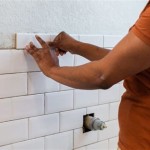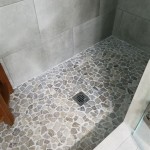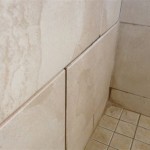What Can I Use To Get Dried Grout Off Tiles and Floors?
Removing dried grout from tile and flooring surfaces can be a challenging task, often requiring a combination of appropriate tools, cleaning agents, and techniques. The longer grout remains on the tile surface, the more difficult it becomes to remove, as it hardens and bonds more strongly with the tile. Selecting the correct approach is essential to avoid damaging the tile while effectively eliminating the grout residue. This article will explore various methods and cleaning solutions effective for removing dried grout, enabling the user to choose the most suitable strategy for their specific situation.
The initial step in the removal process involves identifying the type of grout used during the installation. Common grout types include cement-based, epoxy, and urethane grouts, each possessing different chemical properties. This identification is crucial because it determines the appropriate cleaning agent to use. Using an incorrect cleaner can be ineffective at best and damaging to the tile or grout at worst.
Cement-based grouts, the most widely used type, are porous and susceptible to absorbing water and stains. Epoxy and urethane grouts, on the other hand, are non-porous and highly resistant to water and chemicals. This distinction necessitates different cleaning approaches. Cement-based grouts are typically more easily removed with acidic cleaners, while epoxy and urethane grouts may require specialized solvents or stronger cleaning agents.
Before applying any cleaning solution, it's vital to test it on a small, inconspicuous area of the tile. This test patch helps determine if the cleaner will discolor or damage the tile surface. Allow the cleaner to sit for the recommended duration before wiping it away and inspecting the area for any adverse effects. This precautionary measure can prevent widespread damage and ensure that the chosen solution is appropriate for the particular tile material.
Utilizing Acidic Cleaners for Cement-Based Grout
Acidic cleaners are effective for dissolving cement-based grout. Many commercially available grout haze removers contain mild acids like phosphoric or sulfamic acid. These cleaners work by breaking down the cementitious bonds in the grout, loosening it from the tile surface. Always follow the manufacturer's instructions carefully when using these products.
Before applying an acidic cleaner, dampen the grout and surrounding tile with clean water. This prevents the tile from absorbing the cleaner too quickly, potentially causing damage. Apply the cleaner directly to the dried grout, using a scrub brush or sponge to work it into the residue. Allow the cleaner to dwell for the recommended time, typically a few minutes, but avoid letting it dry completely.
After the dwell time, scrub the area thoroughly with a stiff-bristled brush. Pay particular attention to corners and edges where grout tends to accumulate. Rinse the area thoroughly with clean water to remove all traces of the cleaner and dissolved grout. It is important to neutralize the acid residue, often with a mild alkaline solution like baking soda and water, to prevent any long-term etching or damage to the tile surface.
For stubborn or heavily encrusted grout, a second application of the acidic cleaner may be necessary. Repeat the process, ensuring that the cleaner is applied evenly and allowed to dwell for the appropriate amount of time. In some cases, using a grout removal tool, such as a grout saw or oscillating tool with a grout removal attachment, may be required to physically break up the grout before or after applying the cleaner.
It is essential to use appropriate safety precautions when working with acidic cleaners. Wear gloves, eye protection, and a respirator if necessary to avoid skin, eye, or respiratory irritation. Ensure adequate ventilation in the work area to prevent the build-up of harmful fumes. Dispose of used cleaning materials properly according to local regulations.
Employing Mechanical Methods for Grout Removal
When chemical methods prove insufficient, mechanical methods can be employed to remove dried grout. These methods involve physically breaking up and scraping away the grout residue. A variety of tools are available for this purpose, ranging from simple hand tools to power tools.
A grout saw is a handheld tool designed specifically for removing grout. It consists of a handle and a blade with a coarse, abrasive edge. The blade is used to scrape away the grout in a sawing motion. When using a grout saw, it is important to apply even pressure and avoid damaging the surrounding tile. Work slowly and carefully to prevent chipping or scratching the tile surface.
An oscillating tool with a grout removal attachment is a power tool that uses rapid vibrations to break up and remove grout. This tool is more efficient than a grout saw and can remove grout more quickly. However, it also requires more caution to prevent damage to the tile. Use the tool at a low speed and avoid applying excessive pressure. Move the tool slowly and steadily along the grout line, allowing the vibrations to loosen the grout.
For small areas or delicate tiles, a utility knife or scraper can be used to carefully remove grout. Choose a sharp blade and hold it at a shallow angle to the tile surface. Gently scrape away the grout, being careful not to scratch the tile. This method is best suited for removing small amounts of grout or for cleaning up edges and corners.
After using any mechanical method, thoroughly clean the area to remove any remaining grout debris. Use a vacuum cleaner or brush to sweep away loose particles. Then, wipe the tile with a damp cloth to remove any residual dust or residue. Inspect the area carefully to ensure that all grout has been removed and that the tile surface is clean and undamaged.
Utilizing Steam Cleaning for Grout Removal
Steam cleaning is a versatile method for cleaning and removing grout without the use of harsh chemicals. Steam cleaners use pressurized steam to loosen dirt, grime, and grout residue from tile surfaces. The high temperature of the steam helps to break down the bonds between the grout and the tile, making it easier to remove.
Before using a steam cleaner, sweep or vacuum the area to remove any loose debris. Fill the steam cleaner with water according to the manufacturer's instructions. Attach the appropriate nozzle or brush attachment for grout cleaning. Direct the steam nozzle along the grout lines, allowing the steam to penetrate the grout. Move the nozzle slowly and steadily, overlapping each pass to ensure thorough cleaning.
As the steam loosens the grout, use a scrub brush or sponge to wipe away the residue. For stubborn grout, you may need to make multiple passes with the steam cleaner. After steam cleaning, wipe the tile surface with a clean, dry cloth to remove any remaining moisture. Allow the area to air dry completely.
Steam cleaning is a relatively gentle method for grout removal and is suitable for use on most types of tile. However, it is important to test the steam cleaner on a small, inconspicuous area of the tile first to ensure that it does not cause any damage. Avoid using steam cleaning on porous or unsealed tiles, as the moisture can penetrate the tile and cause staining or damage.
Steam cleaning can be particularly effective for removing stains and mildew from grout. The high temperature of the steam kills mold and mildew spores, helping to prevent future growth. Regularly steam cleaning your tile and grout can help to maintain its appearance and prevent the buildup of dirt and grime.
In addition to these methods, several other cleaning solutions can be used to remove dried grout. These include vinegar and water solutions, baking soda paste, and commercial grout cleaning products. Always test any cleaning solution on a small, inconspicuous area of the tile before applying it to the entire surface. Follow the manufacturer's instructions carefully and use appropriate safety precautions when working with cleaning chemicals.
Ultimately, the best method for removing dried grout depends on the type of grout, the type of tile, and the severity of the residue. Experiment with different methods and cleaning solutions to find the most effective approach for your specific situation. With patience and persistence, it is possible to remove dried grout and restore your tile surfaces to their original appearance.

How To Clean Dried Grout North Country Nest

How To Get Rid Of Leftover Grout Haze Quickly And Easily The Creek Line House

How To Clean Grout Tips For Natural Stone Flooring Granite Gold

How To Get Rid Of Dried Grout On Your Stone Floor Tiles Granite Gold

4 Ways To Clean Grout Off Tile Wikihow

How To Clean Grout On Floor Tile Pro Housekeepers

How To Remove Hard Grout From Tiles Diy Doctor

How To Get Rid Of Leftover Grout Haze Quickly And Easily The Creek Line House

How To Remove Grout Haze A Fast Easy Method Revealed See Before After

How To Clean Dried Grout North Country Nest
Related Posts








